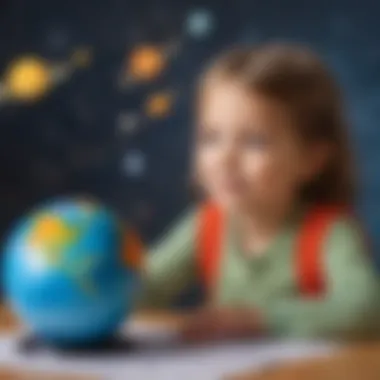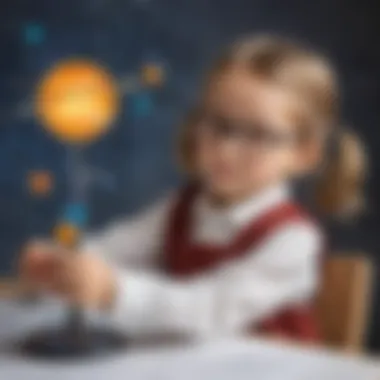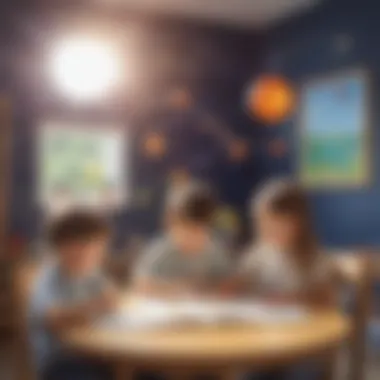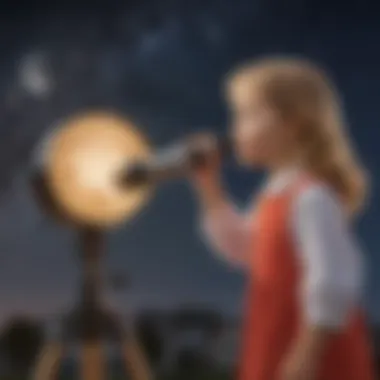Engaging Solar System Experiments for Kindergarten Explorers


Fun Activities Ideas
When it comes to engaging kindergarten children in solar system experiments, there are various fun and educational activities to explore. For indoor activities, setting up a mini solar system model using colorful playdough can be a tactile and visual way for kids to learn about the planets' sizes and positions. Outdoor adventures could involve stargazing nights or using a telescope to observe the moon's phases up close. Arts and crafts can include creating cosmic mobiles using glittered paper and foam balls to depict the solar system's order. Science experiments like making a mock comet by mixing baking soda and vinegar can fascinate children with its fizzing reaction. Cooking and baking can also tie into the theme, with baking star-shaped cookies or creating fruit galaxies combining snack time with learning.
Educational Games
Incorporating educational games into solar system exploration can make learning enjoyable for kindergarten students. Introducing math and logic games such as sorting planets by size or playing a planet-themed puzzle game can enhance numerical and spatial skills. Language and vocabulary games like matching planet names with their characteristics can boost language development while teaching planetary facts. STEM activities such as building a simple rocket launcher using everyday materials can spark an interest in science and engineering at an early age. History and geography puzzles related to celestial events or space exploration missions can provide a holistic understanding of the solar system's context. Interactive learning apps can also supplement traditional games by offering interactive quizzes and visual representations of the solar system.
Seasonal and Holiday Activities
During various holidays and seasons, incorporating solar system-related activities can add a festive and educational touch to celebrations. Valentine's Day crafts could involve making heart-shaped planets or creating a love-themed solar system display. Halloween costume ideas can turn children into their favorite cosmic characters like astronauts or alien beings. Thanksgiving cooking projects could include baking planet-inspired desserts or crafting a thanksgiving constellations chart. Christmas decorations might feature ornaments shaped like the sun or stars to infuse the holiday with a space-themed flair. New Year's resolutions for kids could include setting educational goals related to exploring the solar system further or learning about space discoveries.
Parenting Tips and Resources
For parents, guardians, and teachers guiding kindergarten learners in solar system explorations, there are essential tips and resources to enhance the educational experience. Encouraging creativity can involve allowing children to design their own planets or imagine space missions, fostering imaginative thinking. Setting up a playful learning environment with solar system posters, interactive toys, and books can create an engaging atmosphere for exploring space concepts. Balancing screen time and playtime can involve integrating educational apps or online resources about the solar system into limited screen use periods. Building strong family bonds can be achieved through collaborative solar system projects or stargazing nights that promote togetherness and shared learning experiences. Motivating kids to stay active while learning about the solar system can include physical activities like pretending to be astronauts exploring other planets.
Fun Facts and Trivia
To enrich kindergarten children's understanding of the solar system, fun facts and trivia can pique their curiosity and deepen their knowledge. Exploring the animal kingdom discoveries related to space, such as the effects of zero gravity on animals or animal-inspired spacecraft names, can bring a unique perspective to learning. Delving into famous inventions stories like the development of the first telescope or space suits can highlight the technological advancements that have enabled space exploration. Historical events for kids could include space race milestones or significant space missions that have shaped our understanding of the solar system. Discovering mythical creatures inspired by celestial bodies or constellations can add a imaginative element to solar system learning. Space adventures and discoveries such as iconic moon landings or probes sent to outer planets can inspire awe and wonder in kindergarten learners, sparking their interest in the wonders of the universe.
Introduction to Solar System Education
In this section, we will delve into the significance of introducing kindergarten children to solar system education. Recognizing the importance of laying a strong foundation in early science education can pave the way for a lifelong interest in exploration and discovery. By focusing on specific elements tailored for young learners, we aim to spark curiosity and foster a deep understanding of the solar system.
Importance of Early Science Exploration
Nurturing Curiosity in Young Minds
Nurturing curiosity in young minds is a fundamental aspect of early science exploration. By nurturing this innate sense of wonder, children are encouraged to ask questions, seek answers, and explore the world around them. This approach not only ignites their imagination but also instills a curiosity-driven mindset that is crucial for scientific inquiry. Understanding the importance of nurturing curiosity in young minds lays the groundwork for promoting active engagement with scientific concepts.
Fostering a Lifelong Love for Science
Fostering a lifelong love for science at a young age is a catalyst for shaping future scientists. By instilling a passion for scientific discovery early on, children are more likely to develop a lasting interest in exploring the mysteries of the universe. Emphasizing the joy and fascination of scientific exploration paves the way for a rewarding journey filled with curiosity, experimentation, and discovery. Fostering a lifelong love for science sets the stage for continuous learning and intellectual growth.
Building a Strong Foundation for Learning
Building a strong foundation for learning establishes the framework upon which children can expand their knowledge and skills. By introducing fundamental scientific concepts in an engaging and accessible manner, young learners lay the groundwork for future academic success. Emphasizing the building blocks of scientific understanding equips children with the tools needed to navigate complex scientific concepts with confidence. Building a strong foundation for learning not only cultivates a deep appreciation for science but also nurtures critical thinking skills essential for future academic pursuits.


Benefits of Hands-On Learning
Enhancing Retention and Understanding
Enhancing retention and understanding through hands-on learning experiences is a cornerstone of effective science education. By actively engaging in experiments and exploration, children not only retain information more effectively but also develop a deeper understanding of scientific principles. The tactile nature of hands-on learning reinforces concepts in a memorable way, making learning both enjoyable and impactful.
Promoting Active Engagement
Promoting active engagement through hands-on activities encourages children to become active participants in their learning journey. By fostering a sense of ownership and curiosity, hands-on experiments stimulate interest and engagement with scientific concepts. Active engagement promotes a dynamic learning environment where children are encouraged to explore, question, and discover, leading to a more profound connection with the subject matter.
Encouraging Critical Thinking Skills
Encouraging the development of critical thinking skills is essential for nurturing young scientific minds. By engaging in hands-on experiments that require analysis, problem-solving, and evaluation, children hone their critical thinking abilities. Encouraging a structured approach to experimentation instills a methodical mindset that is crucial for scientific inquiry. Developing critical thinking skills early on prepares children for future academic challenges and instills a lifelong love for learning.
Interactive Solar System Experiments
Creating a Model Solar System
Materials Needed
Materials such as Styrofoam balls, paint, skewers, and a base are essential for creating a model solar system. These materials not only spark creativity but also provide a tangible representation of planetary positions and sizes. The tactile nature of the materials allows for a multi-sensory learning experience, aiding in the comprehension of spatial relationships within the solar system. Their durability and ease of use make them popular choices for engaging children in this model-making activity.
Step-by-Step Instructions
Detailed step-by-step instructions guide children through the process of assembling their model solar system. This hands-on approach fosters creativity and problem-solving skills as children navigate the construction process. Following a systematic guide helps children understand the sequencing of events and reinforces their understanding of planet order and distance from the sun. The instructions offer a structured yet flexible framework for children to explore and experiment with different arrangements.
Key Concepts to Discuss
Key concepts such as planet names, sizes, orbits, and relative positions within the solar system provide valuable learning opportunities. Discussing these concepts with children not only reinforces their understanding of astronomical phenomena but also encourages questions and critical thinking. This activity serves as a gateway for discussing planetary characteristics, exploration, and the vastness of space, triggering curiosity and further exploration into the solar system.
Stargazing with Homemade Telescopes
DIY Telescope Construction
Constructing telescopes using simple materials like cardboard tubes, lenses, and tape allows children to explore celestial bodies up close. The hands-on process of building a telescope enhances children's understanding of optics and magnification, igniting a fascination for astronomy. The affordability and ease of construction make DIY telescopes a popular choice for engaging children in stargazing activities.
Observing Celestial Bodies


Observation sessions enable children to view celestial bodies such as stars, planets, and the moon through their homemade telescopes. This direct interaction with the night sky offers a unique perspective on astronomical objects, promoting curiosity and wonder about the vastness of the universe. Children can develop observational skills and a deeper appreciation for the beauty and complexity of the cosmos.
Discussion on Planets and Stars
Engaging children in discussions about the characteristics and properties of planets and stars deepens their understanding of celestial objects. Exploring factors like size, brightness, and composition prompts critical thinking and encourages children to ask probing questions. These discussions not only enrich children's knowledge of astronomy but also stimulate their imagination and creativity in relation to the mysteries of the universe.
Planetarium Playdough Activity
Recipe for Playdough
Creating playdough using flour, water, salt, and food coloring provides a moldable medium for forming planets. The homemade playdough recipe is safe, cost-effective, and allows children to explore planetary shapes and sizes through hands-on manipulation. The tactile experience of forming planets enhances sensory learning and facilitates discussions on planet characteristics and differences.
Forming Planets with Playdough
Children can shape the playdough into miniature planets, replicating their unique features such as rings, moons, and surface textures. This creative activity prompts discussions on planetary attributes and encourages children to pay attention to detail and accuracy. Forming planets with playdough engages children in a playful yet educational exercise, fostering curiosity and spatial awareness regarding celestial bodies.
Exploring Planet Characteristics
Through the playdough activity, children can explore various planet characteristics such as color, size, and surface features. Manipulating the playdough allows for a hands-on exploration of planetary attributes and serves as a visual aid for discussions on planetary diversity. By engaging in this activity, children develop a deeper understanding of the planets within our solar system and appreciate the intricacies of each celestial body.
Moon Phase Observations
Creating a Moon Phase Chart
Children can chart the phases of the moon using observations and illustrations to understand lunar patterns. This visual representation aids in comprehending the cyclic nature of lunar phases and their connection to the position of the moon in orbit. Creating a moon phase chart encourages children to observe and record natural phenomena, fostering scientific inquiry and observational skills.
Hands-On Observations
Engaging in hands-on observations of the moon allows children to connect theoretical knowledge with real-world experiences. By studying the moon's changing appearance over a lunar cycle, children develop an appreciation for celestial mechanics and the dynamic nature of space. Hands-on observations not only enhance scientific understanding but also instill a sense of wonder and curiosity about the celestial bodies in our solar system.
Understanding Lunar Patterns
Discussing the patterns of lunar phases helps children grasp the concepts of waxing, waning, and full moons. By exploring lunar patterns, children can predict and interpret the moon's phases, fostering critical thinking and analysis skills. Understanding these patterns deepens children's comprehension of astronomical cycles and encourages them to explore the interconnectedness of celestial events within the solar system.
Innovative Teaching Approaches
In this article, we delve into the crucial aspect of innovative teaching approaches for kindergarten children exploring the solar system. Innovative teaching approaches play a pivotal role in shaping the learning experiences of young minds. By integrating unique and creative methods into educational practices, we can enhance children's engagement and comprehension significantly. One of the key benefits of innovative teaching approaches is the ability to cater to diverse learning styles and preferences, ensuring that every child can grasp scientific concepts effectively.


Utilizing Technology in Learning
Virtual Reality Solar System Tours
Virtual Reality (VR) Solar System Tours provide a cutting-edge and immersive experience for young learners. By simulating a realistic journey through the solar system, VR tours enable children to visualize planets and celestial bodies up close, fostering a sense of awe and wonder. The interactive nature of VR tours enhances engagement and retention, making complex astronomical concepts more accessible and memorable for young children. A key characteristic of VR tours is their ability to transport children to space virtually, creating a sensory-rich learning environment that sparks curiosity and excitement. While VR tours offer unparalleled immersion, considerations regarding screen time and potential motion sickness should be taken into account.
Interactive Educational Apps
Interactive educational apps offer a dynamic and interactive way for children to explore the solar system. These apps provide hands-on learning experiences, allowing children to interact with planets, stars, and space phenomena in a fun and engaging manner. The key characteristic of interactive educational apps is their ability to combine entertainment with education, making learning interactive and enjoyable for young learners. By incorporating gamification elements and interactive features, these apps promote active participation and knowledge retention. However, supervision and moderation are essential to ensure that children use apps responsibly and focus on educational content.
Online Astronomy Resources
Online astronomy resources serve as valuable tools for supplementing traditional classroom learning. These resources provide access to a wealth of information, including articles, videos, and virtual simulations, allowing children to explore the wonders of the universe at their own pace. A key characteristic of online astronomy resources is their versatility and accessibility, enabling children to delve into specific topics of interest and expand their knowledge beyond the classroom. While online resources offer convenience and depth of content, it is essential to discern credible sources and guide children in navigating online information safely.
Incorporating Storytelling and Art
Incorporating storytelling and art into solar system education adds a creative and expressive dimension to learning. By intertwining narrative elements and artistic activities, educators can captivate children's imagination and enhance their understanding of astronomical concepts in a meaningful way. Storytelling and art spark curiosity, encourage self-expression, and stimulate critical thinking skills, fostering holistic development in young learners.
Creating Solar System Storybooks
Creating solar system storybooks combines the magic of storytelling with scientific exploration. These narrative-driven books take children on imaginative journeys through the solar system, introducing them to planets, moons, and cosmic adventures. The key characteristic of solar system storybooks is their ability to weave scientific facts into engaging narratives, making complex information accessible and relatable for young readers. By blending creativity with factual content, these storybooks inspire a love for learning and curiosity about the universe.
Art Projects Inspired by Space
Art projects inspired by space allow children to express their creativity and imagination while exploring celestial themes. From crafting paper mache planets to painting galaxy-inspired scenes, art projects engage children in hands-on activities that bridge artistic expression with scientific concepts. The key characteristic of space-inspired art projects is their ability to encourage experimentation and individuality, fostering a sense of exploration and discovery. By integrating art into scientific learning, children can visualize abstract concepts and develop a deeper appreciation for the beauty of the cosmos.
Role of Creativity in Learning
The role of creativity in learning is paramount in nurturing innovation and ingenuity in young minds. By encouraging creative thinking and problem-solving skills, educators empower children to explore concepts through unconventional perspectives and imaginative processes. The key characteristic of creativity in learning is its capacity to cultivate flexibility and adaptability, essential traits in navigating complex scientific subjects. By fostering a creative learning environment, educators can inspire curiosity, persistence, and a lifelong passion for exploration in children.
Parental Involvement and Resources
Guidance for Parents
Encouraging Exploration at Home
Encouraging Exploration at Home is a vital component in enhancing a child's understanding of scientific concepts discussed in this article. By creating a stimulating environment for exploration, parents can spark individual curiosity and independent learning. The key characteristic of this approach lies in promoting hands-on experimentation and discovery, allowing children to explore the mysteries of the solar system at their own pace. This method is highly beneficial for encouraging active participation and critical thinking skills in young learners.
Supporting Science Interests
Supporting Science Interests among children is essential for nurturing a curiosity-driven mindset and sustaining a keen interest in scientific exploration. By providing resources, encouragement, and positive reinforcement, parents can empower their children to delve deeper into scientific phenomena, fostering a sense of wonder and inquiry. The unique feature of this approach lies in channeling a child's natural curiosity into a structured exploration of scientific concepts, building a strong foundation for future learning. While the advantages of supporting science interests are abundant, such as promoting cognitive development and stimulating creativity, it is important to note that a balanced approach is needed to prevent overwhelming young learners.
Building a Learning Environment
Creating a conducive learning environment is paramount in supporting a child's educational journey and fostering a love for science. By setting up a space filled with educational materials, engaging activities, and opportunities for exploration, parents can establish a rich learning environment that stimulates a child's intellectual growth. The key characteristic of this approach is to provide a nurturing and supportive setting where children feel valued and encouraged to explore their interests. While the advantages of building a learning environment align with promoting a sense of independence and self-directed learning, parents should be mindful of maintaining a balance between structured learning and free exploration to optimize their child's educational experience.



